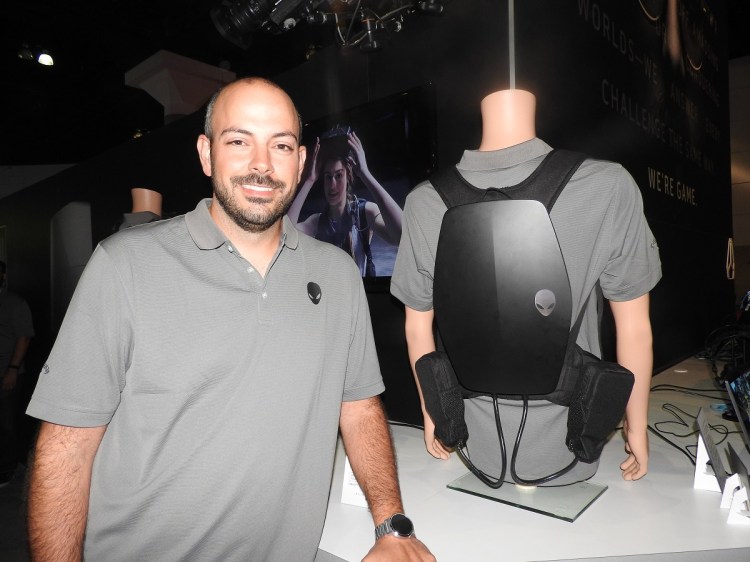Alienware was founded 20 years ago to make gaming PCs. And at the most recent Electronic Entertainment Expo (E3), it showed off a bunch of new products such as the Alienware Alpha desktop, the full-tower Area 51, the OLED-based Alienware 13, and a backpack and computer that enables players to wear a PC on their back while they play virtual reality games.
Those machines offer screaming performance to players who want exceptional graphics quality. But now the PC is changing, as Microsoft is trying to drive Windows 10 and Xbox gaming and its Project Scorpio game console (coming in holiday 2017) into a kind of converged product.
GamesBeat talked about the 20th anniversary of Alienware and the convergence of PC and console gaming with Frank Azor, a cofounder of Alienware and general manager of the gaming division of Dell.
Here’s an edited transcript of our interview.

Above: Alienware 13 with OLED screen.
Frank Azor: We’ve done a lot of firsts over our 20 years. We made the first gaming notebook, and now look how big that market is. The first liquid-cooled desktop. It’s hard to see a gaming desktop today that isn’t liquid-cooled. The first customer-creatable external graphics. Just a year and a half ago we launched that. The first PC console. We saw a couple of competitors coming out with things like that. So who knows where we’ll be in the next 20 years?
The main recurring theme here is that except for the 13 inches, every product has VR consideration in it. The Area 51 is obviously VR capable. The Aurora is VR capable and designed to scale with your VR experience. Looking at the Alpha R2, we have a VR path there as well. VR is going to be as relevant to our future as PC gaming has been to our past.
GamesBeat: I’m curious where you think some of this is going. Microsoft’s Project Scorpio almost implies a kind of fusion between PC and console. Do you see that happening as well? How does PC gaming stay distinct from console gaming given that kind of road map?
Azor: The lines between PC and console gaming are blurry. They’re going to get blurrier and eventually disappear. Scorpio is proof of that evolution.

Above: Phil Spencer at E3 2016
GamesBeat: If you’re going to upgrade your Scorpio, is it going to upgrade the way a console upgrades, or the way a PC upgrades? Do I pull something out and plug something in? I wonder.
Azor: PC will continue to have distinct advantages in certain areas, but it’ll come at a price premium. Xboxes, whatever flavor they may be, they’ll have advantages as well, but they’ll have an opposing disadvantage compared to what PC architecture can offer. Upgradability is one of those things. The option to run different operating systems, to sideload content, to live in an open ecosystem—those things will probably remain properties of the traditional PC.
These are all assumptions, though. What they revealed yesterday is maybe 75 percent of what they’ll eventually end up doing. We saw so much change between the Xbox One launch and today. It’s good that Microsoft is able to adapt.
GamesBeat: What strategy do you guys have in a changing landscape?
Azor: We laid out our strategy pretty clearly two years ago when we launched the Alienware Alpha, and then shortly after that the Steam Machine. We believe the PC is the best platform for the living room. It’s the most open platform. It’s the most powerful platform. It provides the option to upgrade. It can scale with you over time. You don’t lose backward compatibility with games and apps you love. It has the largest library of content and games.
There are so many advantages compared to every other appliance we’ve put next to our TVs over the decades. It’s the only appliance that’s survived those decades, if you think about it. We were at HD resolution 10 years ago when TVs were just barely getting there. We jumped in early and helped define that category in a lot of ways – not only with Alpha and with Steam Machines, but we were doing living room form factors in 2003. We were building products like the Hangar 18 and the DHS, learning what it takes to put a PC in the living room.

Above: Alienware Area-51 desktop
Now these latest iterations have been the most successful machines we’ve ever built. They’re smaller and more user-friendly. The ecosystem has changed considerably as well. I don’t have to put an optical drive in this anymore. I don’t need a TV tuner or a cable card. The content comes in via Ethernet more than traditional media formats. We’ve been able to shrink the form factor, consolidate content, and get rid a lot of those cards and things that made the experience less user-friendly.

